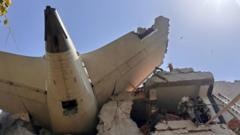*An analysis of the crash of Air India Flight AI171 reveals concerning airline safety and procedures, weighing various theories and expert opinions in the absence of official conclusions.*
**Tragic Crash of Air India Flight AI171: Investigating the Causes Behind the Calamity**

**Tragic Crash of Air India Flight AI171: Investigating the Causes Behind the Calamity**
*Flight AI171 from Ahmedabad to London met with disaster shortly after take-off, igniting discussions on potential failure factors.*
The Air India Flight AI171 tragedy, which resulted in the loss of 241 lives shortly after take-off from Ahmedabad International Airport, has raised significant questions about possible causes in the aviation community. As investigators from India, the US, and the UK gear up to analyze the situation, the focus is on understanding the challenges faced during the critical moments of take-off.
The Boeing 787-8 Dreamliner departed at 13:39 local time carrying 242 people, including a full load of fuel, when it emitted a mayday transmission almost immediately post-takeoff. Following this alert, the aircraft swiftly lost altitude, crashing into densely populated residential buildings within 30 seconds of takeoff. Eyewitness accounts and video evidence suggest the plane struggled to gain height, with reports of a loud bang that preceded the descent.
Experts are exploring various theories regarding the accident, with speculation centering around a rare double engine failure as a possible cause. Aviation professionals noted the challenges pilots might face with such a malfunction, leaving them with little time to respond. Furthermore, the potential implications of fuel contamination or clogging causing a failure in both engines have also been discussed.
Another theory involves a possible bird strike, as Ahmedabad's airport has a notorious record of such incidents. Over the past five years, the region reported numerous bird strikes, raising concerns about bird hazards during takeoff. While bird strikes can significantly affect engine performance, experts suggest that catastrophic outcomes are uncommon unless both engines are impacted.
Discussions have also arisen around the aircraft's flaps, crucial for generating lift during take-off. If the flaps were not extended correctly, which contributes to hover capability, it could have led to the crash. However, pilots assert that such a configuration error would typically trigger alarms within the aircraft system, indicating a potential human error on the crew's part.
While investigations will focus on various elements, including assessments of flight data records and physical debris, the final conclusions remain pending. As the aviation world watches closely, the aftermath of Flight AI171 marks a pivotal moment for safety protocols and preventive measures in international air travel, emphasizing the need for continuous improvement in aircraft operation procedures and emergency readiness.
As authorities delve deeper into understanding the factors that led to this disaster, the insights gathered will be essential for ensuring that such tragedies are mitigated in the future.
The Boeing 787-8 Dreamliner departed at 13:39 local time carrying 242 people, including a full load of fuel, when it emitted a mayday transmission almost immediately post-takeoff. Following this alert, the aircraft swiftly lost altitude, crashing into densely populated residential buildings within 30 seconds of takeoff. Eyewitness accounts and video evidence suggest the plane struggled to gain height, with reports of a loud bang that preceded the descent.
Experts are exploring various theories regarding the accident, with speculation centering around a rare double engine failure as a possible cause. Aviation professionals noted the challenges pilots might face with such a malfunction, leaving them with little time to respond. Furthermore, the potential implications of fuel contamination or clogging causing a failure in both engines have also been discussed.
Another theory involves a possible bird strike, as Ahmedabad's airport has a notorious record of such incidents. Over the past five years, the region reported numerous bird strikes, raising concerns about bird hazards during takeoff. While bird strikes can significantly affect engine performance, experts suggest that catastrophic outcomes are uncommon unless both engines are impacted.
Discussions have also arisen around the aircraft's flaps, crucial for generating lift during take-off. If the flaps were not extended correctly, which contributes to hover capability, it could have led to the crash. However, pilots assert that such a configuration error would typically trigger alarms within the aircraft system, indicating a potential human error on the crew's part.
While investigations will focus on various elements, including assessments of flight data records and physical debris, the final conclusions remain pending. As the aviation world watches closely, the aftermath of Flight AI171 marks a pivotal moment for safety protocols and preventive measures in international air travel, emphasizing the need for continuous improvement in aircraft operation procedures and emergency readiness.
As authorities delve deeper into understanding the factors that led to this disaster, the insights gathered will be essential for ensuring that such tragedies are mitigated in the future.





















